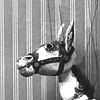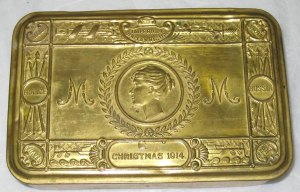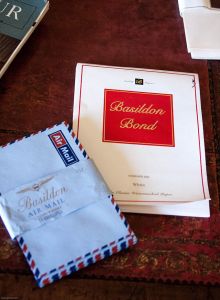[269] Elizabeth Martha
Issued August 2015. Revised and reissued February 2020.
She was born in 1892, in an era that was very different, before aeroplanes, before cars, before the common use of electricity and telephones and, of course, long before computers. She was the second oldest of a family of eleven children. Some of the children died very young.
She started work at the same place as her older sister so there she was introduced as a younger sister. For the rest of her life, her family and friends called her ‘Cissie.’
I don’t know much about her early life but she became pregnant in 1914. Frederick did the honourable thing, which in those days was very important, and they were married a few months before she had a baby girl – the only child she would ever have. If you haven’t guessed already, the child was my mother, of whom a little more will be said in another blog.
Her husband, eight years older than her, had served in the Royal Navy for several years before meeting her and he re-enlisted when the war started, so she saw little of him. He served through the First World War and returned for just a few years before dying from an infection (caught while working for the GPO in sewers) in 1924.
Cissie lived for the rest of her life, another 55 years, as a widow. To us she was ‘Nan,’ and no one ever called her anything else. (Perhaps Mum sometimes called her ‘Mum.’ I’m not sure.) Unlike my other grandmother, who I can only remember seeing once, we saw her often even before she came to live with us. With a family of six children, sometimes in holiday periods Nan looked after two or three of us.
I have one vague memory of visiting where she used to live in Poplar in East London. It was a first floor flat and she had a portable gas fire.
She must have worked for most of her life (before the days of Social Security) but I am not sure where. Perhaps she was working part-time when we knew her first. The only work that she ever mentioned was at the ‘Section House,’ which was Lime Street Police headquarters in London. I’m pretty sure she worked there as a cleaner.
She came to live with us in 1957, two years after we moved. As you know ([254] Halfway up the Drive) we had no spare bedrooms so at first she shared a room with my two little sisters. When my older brother married and left home, Nan had his small bedroom as her own.
I do remember two of her lifetime friends who sometimes visited, Aunt Nell and Uncle Albert from East Ham. In those days friend of adults were always ‘Uncle’ or ‘Aunt’ to children. I think they were very close. I found out later that Nan had a brief engagement to a young man who died when they were both seventeen. He was Nell’s brother.
What can I say about my grandmother? She shared a lot of the housekeeping tasks with Mum and always seemed to be busy. She did some of the cooking and sometimes ironed. (I remember sometimes she didn’t use an ironing board. Perhaps they were too modern for her. She put a blanket on the table in the morning room and ironed on that.)
She had two housecoats, one red and one blue, and wore them all the time. She had lived through two Wars and her motto was ‘Waste not, want not.’ When we were very young clothes were sometimes patched and she even darned socks. (You may have to look up ‘darn.’)
To us she was always an old lady, at a time when anyone over 65 was more or less seen as infirm and decrepit. In those days people ate their meals together. We used to eat in what we called the Morning Room and we used the Dining room on Sundays. (I may not have mentioned that the Snooker table converted to an excellent dining table.) From the day she joined us, Nan never felt comfortable doing this and would always eat alone in the lounge or the kitchen, even on Christmas Day.
Her health was never that good but she never complained. I remember two or three heart attacks. Our local GP came when called (as doctors did in those days) and recommended a medicinal brandy. I also remember her coming back from the surgery several times and saying that he had told her not to do any work in the house. Her reply to him was always, “Well, I live with my daughter,” which implied that she led a life of leisure, but she didn’t stop working.
She was short and didn’t quite walk with a limp but one leg was shorter than the other. She wore clumpy, leather shoes, which had to be made to order – one had a thick sole to make her stand level. She needed glasses, both for distance and for reading and two pairs were clearly identified by the red and blue glasses cases in which she kept them. She was always losing them and asking us to find them.
She never bothered to tell us that she was completely blind in one eye. It became evident later when the sight of the remaining eye deteriorated with a cataract. (It was the result of an infection many years earlier in a hospital for something insignificant. Nowadays people would make extensive claims for damages but back then the secrecy of the medical profession meant that no one was seen to be responsible.) For her last few years she was completely blind, continuing to live with Mum and Dad.
They say that parents and grandparents should not admit to having favourites but I was without doubt her favourite grandchild. It was said that even at birth I looked like her late husband. I was given his name as my middle name and was always known as Fred at school, Ilford County High School. (There were too many Alans.) I have his Navy medals, in the familiar Christmas 1914 box from Princess Mary, and a sturdy lockable wooden box that went with him on ships over a hundred years ago.
I think she may have brought a few early records with her and from those I date my love of Teresa Brewer as in [226] ‘All I want is Music, Music, Music, Music!’ and [234] ‘Everything I Do …’
Luxuries
In the Fifties and Sixties, life expectancy was much less. People were middle-aged in their forties and old in their sixties. Old men were seen much less often and typically old women went round with walking sticks. (I never saw either of my grandfathers, who both died before I was born.)
This is as much about being old in the Fifties and Sixties as it is about a particular person. But I want to show how hard times were by modern standards (and had been earlier still as our grandparents had grown up) by looking at what my grandmother considered to be the luxuries of her very mundane life.
It has always been hard to decide what to buy older people for Christmas or a birthday and if we asked her there were only ever four things on the list. I expect she had a stockpile that she used carefully.
In the Sixties there was no such thing as liquid foam bath or bubble bath – or even what we now call shower gel. We just used soap and water. Chemists or shops like Woolworths would sell either bath salts (in a glass jar) or bath cubes in a box. The more up market wrapped cubes would come out at Christmas, definitely a luxury. We didn’t have anything like that at home but one cube a week was a luxury for an old lady.
The main way that Nan maintained contact with her surviving brothers and sisters was by writing letters, as people did in those days. The standard way of doing that was to use writing paper with matching envelopes. Basildon Bond somehow had the aura of being the best but there were other similar brands available.
I’m beginning to see that as well as being luxuries, this small list shows about the only personal things she ever had or used.
As a family, sweets and chocolates were not part of our ordinary daily life. The Duncan’s Walnut Whirls only came at Christmas. We all had our preferences for very occasional treats, just about only for birthdays. Nan like Quality Street, which always had an old-fashioned look.
(Wikipedia tells me that in the early 1930s only the wealthy could afford boxed chocolates, with exotic ingredients and sometimes with elaborate packaging that cost as much as the chocolates themselves. Quality Street was designed to be sold at a reasonable price, available to working families. Different toffees covered with chocolate came in low-cost yet attractive boxes. Rather than having each piece separated in the box, which required more costly packaging, each chocolate was individually wrapped in coloured paper, in a decorative tin. New technology, the world’s first twist-wrapping machine, was used to wrap each chocolate in a distinctive wrapper.
Britain was still feeling the effects of the economic crash and Mackintosh realized that in times of economic hardship and war, people crave nostalgia. Quality Street chocolates were, packaged in brightly coloured tins featuring two characters wearing old fashioned dress, known affectionately as Miss Sweetly and Major Quality. ‘The Major’ and ‘Miss’, two figures inspired by the play’s principal characters, appeared on all Quality Street boxes and tins until 2000.)
For Ena Sharples of Coronation Street it was just milk stout; for the actor Bernard Miles it was Mackeson: “It looks good, tastes good and, by golly, it does you good” (from a long running advertising series); for the Irish it has always been Guinness. The adverts used to say: ‘Guinness is good for you.’ In those days adverts could say what they liked!
She always had a Guinness every morning, poured slowly and carefully from a bottle. It was generally accepted in medicine at least as a tonic and may have been recommended by her doctor. It gave her a short period of relaxation in the day.
This is an example of what older people were like in the Fifties. It’s not an obituary. But no one ever had a better grandmother.
It was only when I came to look into my family history some years ago that I found out her name. I never heard anyone use it. She was Nan to us, Cissie to older relatives.
She was Elizabeth Martha G_. It’s a nice name and it’s how I think of her now sometimes.








05/08/2015 at 15:58
A very nice personal piece! You have a good memory of a lovely personality, quite touching.
LikeLiked by 1 person
05/08/2015 at 21:58
Dear Alan:
Thank you so much for your articles, particularly this one, a most personal one. Growing up at approximately the same time as you, only streets away, is mirrored by so many of your experiences. Best to you and Judy
LikeLiked by 1 person
06/08/2015 at 13:22
My Nanna lived with us. She always had a Guinness whilst cooking the Sunday roast. I used to go down to the local Off Licence on my bike to get it for her – and a packet of crisps for me. Sunday afternoons she used to love watching the wrestling on the tele.
LikeLiked by 1 person
06/08/2015 at 15:04
I think television wrestling may get a mention eventually in a blog.
LikeLike
Pingback: [71] Another Picture Blog | Remembrance of Things Past
Pingback: [76] Rolling Pins and Mincers | Remembrance of Things Past
Pingback: Lest we Forget | Remembrance of Things Past
Pingback: [88] Christmas Comes but Once a Year | Remembrance of Things Past
Pingback: [89] Honour Thy father and Thy Mother | Remembrance of Things Past
Pingback: [91] Sing, Choir of Angels … | Remembrance of Things Past
Pingback: [96] “The Wisdom to Know …” | Remembrance of Things Past
Pingback: [109] Growing Up | Remembrance of Things Past
Pingback: [110] Dedicated Follower | Remembrance of Things Past
22/09/2019 at 18:09
Nanto me was the epitome of a strong kind great woman. Having run a soup kitchen in the war and being bombed out three times. She was dealt a tough life she continued to support her daughter, my mother in law. She lost a child, worked all her life but she showed me that there is always a good way through. I loved her very much and missed her even more when I left her family. A truly great Londoner and friend.
LikeLike